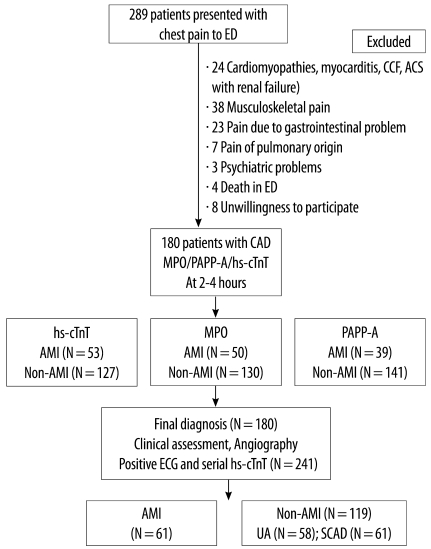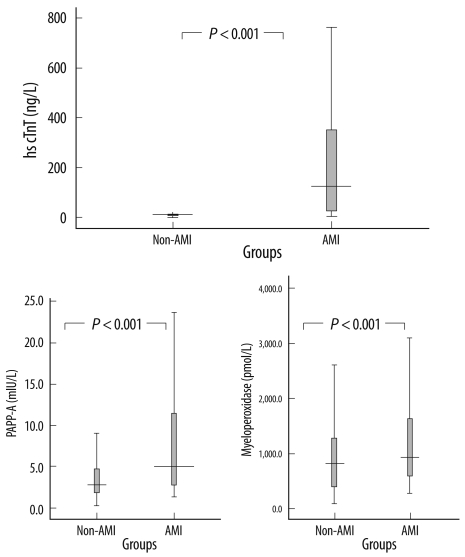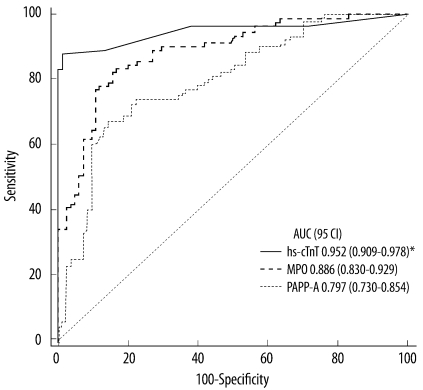Korean J Lab Med.
2011 Jul;31(3):172-178. 10.3343/kjlm.2011.31.3.172.
Diagnostic Performance of High-Sensitivity Troponin T, Myeloperoxidase, and Pregnancy-Associated Plasma Protein A Assays for Triage of Patients with Acute Myocardial Infarction
- Affiliations
-
- 1Department of Pathology, Army Medical College National University of Sciences and Technology, Islamabad, Pakistan. dakhan@cpsp.edu.pk
- KMID: 1735850
- DOI: http://doi.org/10.3343/kjlm.2011.31.3.172
Abstract
- BACKGROUND
Early diagnosis is the cornerstone of management of acute myocardial infarction (AMI). We aimed to compare the diagnostic accuracy of high-sensitivity troponin T (hs-cTnT) with myeloperoxidase (MPO) and pregnancy-associated plasma protein A (PAPP-A) for early diagnosis of AMI in patients at the time of presentation to the emergency department (ED).
METHODS
We enrolled 289 patients who presented at the ED of the National Institute of Heart Disease (NIHD) Rawalpindi, Pakistan, within 4 hr of onset of chest pain. Clinical assessment, electrocardiography (ECG), and angiography were carried out. Blood samples were collected at 0, 3, 6, and 12 hr. Analyses of plasma hs-cTnT, MPO, and PAPP-A were carried out using commercial kits.
RESULTS
Out of 289 subjects who presented to the ED, we diagnosed 180 patients with coronary heart disease as having AMI (N=61) and 119 as without AMI (stable coronary artery disease, N=61; unstable angina, N=58). Compared to non-AMI patients, the patients with AMI had significantly higher levels (represented here as median [inter quartile range]) of plasma hs-cTnT (136 [39-370] vs. 12 [7-21] ng/L), MPO (906 [564-1,631] vs. 786 [351-1,299] pmol/L) and PAPP-A (5.78 [2.67-13.4] vs. 2.8 [1.8-4.9] mIU/L). Receiver operator characteristic curves (95% CI) for hs-cTnT (0.952 [0.909-0.978]) were significantly higher (P<0.001) than those for MPO (0.886 [0.830-0.929]) and PAPP-A (0.797 [0.730-0.854]), with AMI sensitivity and specificity percentages of 87% and 98% (hs-cTnT), 82% and 84% (MPO), and 65% and 87% (PAPP-A), respectively.
CONCLUSIONS
The diagnostic performance of hs-cTnT was superior to that of MPO and PAPP-A for early triage and diagnosis of AMI among patients of coronary heart disease presenting with chest pain to the ED.
Keyword
MeSH Terms
-
Acute Disease
Adult
Aged
Aged, 80 and over
Biological Markers/blood
Coronary Angiography
Early Diagnosis
Electrocardiography
Female
Humans
Male
Middle Aged
Myocardial Infarction/blood/*diagnosis/radiography
Peroxidase/*blood
Pregnancy-Associated Plasma Protein-A/*analysis
ROC Curve
Time Factors
Triage
Troponin T/*blood
Figure
Reference
-
1. Thygesen K, Alpert JS, White HD. Universal definition of myocardial infarction. J Am Coll Cardiol. 2007; 50:2173–2195. PMID: 18036459.2. Menown IB, Mackenzie G, Adgey AA. Optimizing the initial 12-lead electrocardiographic diagnosis of acute myocardial infarction. Eur Heart J. 2000; 21:275–283. PMID: 10653675.
Article3. Bassand JP, Hamm CW, Ardissino D, Boersma E, Budaj A, Fernández-Aviléz F, et al. Guidelines for the diagnosis and treatment of non-ST-segment elevation acute coronary syndromes. Eur Heart J. 2007; 28:1598–1660. PMID: 17569677.4. Reichlin T, Hochholzer W, Bassetti S, Steuer S, Stelzig C, Hartwiger S, et al. Early diagnosis of myocardial infarction with sensitive cardiac troponin assays. N Engl J Med. 2009; 361:858–867. PMID: 19710484.
Article5. Gururajan P, Gurumurthy P, Nayar P, Babu S, Sarasabharati A, Victor D, et al. Serum myeloperoxidase: a novel biomarker for evaluation of patients with acute coronary syndrome. Heart Asia. 2009; 1:41–46.6. Brennan ML, Penn MS, Van Lente F, Nambi V, Shishehbor MH, Aviles RJ, et al. Prognostic value of myeloperoxidase in patients with chest pain. N Engl J Med. 2003; 349:1595–1604. PMID: 14573731.
Article7. Bayes-Genis A, Conover CA, Overgaard MT, Bailey KR, Christiansen M, Holmes DR Jr, et al. Pregnancy-associated plasma protein A as a marker of acute coronary syndromes. N Engl J Med. 2001; 345:1022–1029. PMID: 11586954.
Article8. Lund J, Qin QP, Ilva T, Pettersson K, Viopio-Pulkki LM, Porela P, et al. Circulating pregnancy-associated plasma protein-A predicts outcome in patients with acute coronary syndrome but no Troponin-I elevation. Circulation. 2003; 108:1924–1926. PMID: 14530192.9. Iversen KK, Teisner AS, Teisner B, Kliem A, Thanning P, Grande P, et al. Pregnancy associated plasma protein A, a novel, quick, and sensitive marker in ST-elevation myocardial infarction. Am J Cardiol. 2008; 101:1389–1394. PMID: 18471447.
Article10. McCann CJ, Glover BM, Menown IB, Moore MJ, McEneny J, Owens CG, et al. Novel biomarkers in early diagnosis of acute myocardial infarction compared with cardiac troponin T. Eur Heart J. 2008; 29:2843–2850. PMID: 18682444.
Article11. DeLong ER, DeLong DM, Clarke-Pearson DL. Comparing the areas under two or more correlated receiver operating characteristic curves: a nonparametric approach. Biometrics. 1988; 44:837–845. PMID: 3203132.
Article12. Keller T, Zeller T, Peetz D, Tzikas S, Roth A, Czyz E, et al. Sensitive troponin I assay in early diagnosis of acute myocardial infarction. N Engl J Med. 2009; 361:868–877. PMID: 19710485.
Article13. Achar AS, Kundu S, Norcross WA. Diagnosis of acute coronary syndrome. Am Fam Physician. 2005; 72:119–126. PMID: 16035692.14. Giannitsis E, Becker M, Kurz K, Hess G, Zdunek D, Katus HA. High-sensitive cardiac troponin T for early prediction of evolving non-ST-segment elevation myocardial infarction in patients with suspected acute coronary syndrome and negative troponin results on admission. Clin Chem. 2010; 56:642–650. PMID: 20167697.15. Apple FS, Smith SW, Pearce LA, Murakami MM. Assessment of the multiple-biomarker approach for diagnosis of myocardial infarction in patients presenting with symptoms suggestive of acute coronary syndrome. Clin Chem. 2009; 55:93–100. PMID: 19028826.
Article16. Khan SQ, Kelly D, Quinn P, Davies JE, Ng LL. Myeloperoxidase aids prognostication together with N-terminal pro-B-type natriuretic peptide in high-risk patients with acute ST elevation myocardial infarction. Heart. 2007; 93:826–831. PMID: 17194712.
Article17. Mocatta TJ, Pilbrow AP, Cameron VA, Senthilmohan R, Frampton CM, Richards AM, et al. Plasma concentrations of myeloperoxidase predict mortality after myocardial infarction. J Am Coll Cardiol. 2007; 49:1993–2000. PMID: 17512353.
Article18. Ndrepepa G, Braun S, Mehilli J, von Beckerath N, Schomig A, Kastrati A. Myeloperoxidase level in patients with stable coronary artery disease and acute coronary syndrome. Eur J Clin Invest. 2008; 38:90–96. PMID: 18226042.19. Esporcatte R, Rey HCV, Rocha RM, Bittencourt MI, Salgado CS, Garcia MI, et al. Impact of myeloperoxidase dosage in acute coronary syndrome. Crit Care. 2005; 9(S2):S30.
- Full Text Links
- Actions
-
Cited
- CITED
-
- Close
- Share
- Similar articles
-
- Diagnostic Value of the Triage(R) Cardiac System for Acute Myocardial Infarction: Comparison with Established Devices
- Troponin assay use in the emergency department for management of patients with potential acute coronary syndrome: current use and future directions
- Efficacy of the Troponin T Rapid Assay Kit in Early Diagnosis of Acute Myocardial Infarction
- Diagnostic Efficiency of Lactate Dehydrogenase, Crreatine Kinase and Troponin T in Acute Myocardial Infarction
- Analytical Characteristics of High-Sensitivity Cardiac Troponin Assays




